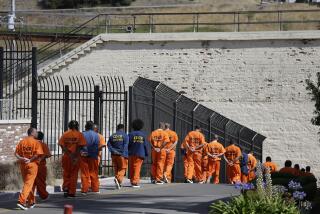Editorial: State laws on sex offenders should not be crafted by emotion
Jessica’s Law — California’s version of it, anyway — was a mess from the beginning. Voters here adopted it (as Proposition 83) in 2006 because they mistakenly believed they were cracking down on horrific crimes against children. They were urged on by nightly harangues from national TV commentators who campaigned on-air for swift action following the rape and murder of 9-year-old Jessica Lunsford in Florida, a crime that touched an especially sensitive nerve here because the circumstances nearly mirrored the nightmarish killing of Polly Klaas in California a decade earlier. But emotional outpourings of fear, revulsion and collective guilt too often translate poorly into policy and law, and that was surely the case with Proposition 83.
The latest reminder of the law’s failure came last week, when state parole officials announced that they would no longer enforce the measure’s blanket ban on paroled sex offenders living within 2,000 feet of a school or park where children regularly gather.
That decision follows a state Supreme Court ruling this month invalidating the ban as it applied in San Diego County.
Californians have every right to protect their children from child molesters, so it would be understandable if they were perplexed by the actions of the court and corrections officials — until they realize that the residency restriction did nothing of the sort.
In fact, it likely undermined public safety for everyone, children included, by pushing paroled sex offenders from their homes and compelling them to live homeless or as transients, leaving the public in the dark as to their whereabouts and making parolees harder for agents to find.
Besides, it is important to remember that the law did not single out child molesters. It did not distinguish parolees at high risk to commit new crimes, or those more likely to target children, from any of the other 6,000 parolees required to register as sex offenders — or indeed any of the approximately 80,000 Californians not on parole but with a sex offense on their record.
Proposition 83 had such broad appeal in part because it ignored those kinds of distinctions. Little thinking was required. A person was either required to register as a sex offender or not. And if he or she was, it was a simple jump to conclude that any “sex offender” was a “child molester” — and from there, a “pedophile,” a “sexual predator,” a “sexually violent predator” or a “mentally disordered sex offender.” Commentators and campaigners readily conflated those terms and engaged in a kind of definition creep that allowed, even encouraged, voters to believe that everyone on the sex offender registry was necessarily violent, targeted children and was more likely than other criminals to re-offend. None of that is true.
That misperception is a problem, and not just because of concern for the rights of sex offenders. Californians can be forgiven if they keep their safety and that of their children foremost in their minds, ahead of justice for criminals. But it’s a problem as well because it leads us to believe we are properly, effectively and efficiently expending public safety resources when we are not. Just as societal concern about rampant drug abuse led to laws that filled prisons with drug users, strained budgets and deflected attention from more violent crimes, the unfocused application of sex offender laws hurts rather than enhances public safety.
It’s important to remember that California has had a sex offender registry since 1947, and that its purpose is to safeguard the innocent from people who are deemed to pose a particular, continuing risk even after their sentences have been served and their parole has been completed.
But behavioral science and criminal justice research have come a long way since the 1940s. It was once thought that people convicted of crimes involving sex suffered from disorders that made them constant threats to re-offend; or at least that it was impossible to distinguish between those who did pose such a risk and those who did not.
In fact, long-term studies of the general population of sex offenders show recidivism rates much lower than for the population of all criminals. But for particular subgroups, the risk of re-offending is much higher.
The California Department of Corrections and Rehabilitation determines whether an inmate soon to be released on parole is at high risk of committing another offense and, if so, that parolee may not live within a half-mile of a school. That properly tailored law was in effect before Proposition 83’s blanket residency restrictions on anyone on the offender registry and properly remains in effect today even after the court ruling and the decision by the parole department to change its enforcement strategy.
Also, special restrictions will continue to apply to sexually violent predators — people who have been convicted of sexually victimizing another person and who have diagnosed mental conditions that make them likely to engage in additional sexually violent crimes. Even after such people are released from prison, they can be committed by the Department of State Hospitals until they are deemed to no longer pose a threat.
It makes sense to craft laws to protect the public based not on some sweeping designation of “sex offender” but rather on the risks posed by each subgroup and, when possible, by the particularized risk of each offender. The court ruling and the parole decision move California in that direction.
But there is pushback, and it is cause for concern. Public officials and commentators freely label any sex offender as a “predator,” implying that each such person poses an equal risk to the public and thus must be equally restricted and supervised. Clearer thinking, based on data rather than emotion or demagoguery, would serve California better.
Follow the Opinion section on Twitter @latimesopinion and Facebook
More to Read
A cure for the common opinion
Get thought-provoking perspectives with our weekly newsletter.
You may occasionally receive promotional content from the Los Angeles Times.






